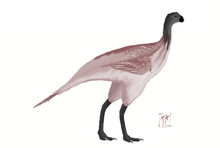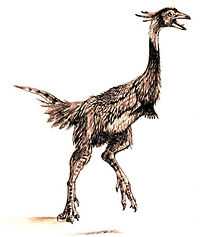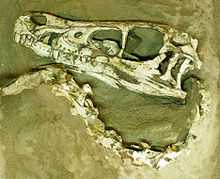Iren Dabasu Formation
| Iren Dabasu Formation Stratigraphic range: Santonian | |
|---|---|
| Type | Geological formation |
| Overlies | Arshanto Formation |
| Area | Iren nor near Erlian city |
| Thickness | 30m |
| Location | |
| Region | Inner Mongolia |
| Country | China |
The Iren Dabasu Formation is a Mesozoic geologic formation in the Iren Nor region of Inner Mongolia. Dinosaur remains diagnostic to the genus level are among the fossils that have been recovered from the formation.[1] The Upper Cretaceous Iren Dabasu Formation in the Iren Nor region of Inner Mongolia is typically referred to continental clastic sediments consisting of light grey fine sandstones, coarse sandstones and glutenites as well as mottled claystones and siltstones. This lithological unit has yielded plentiful dinosaur remains in quantity and group, also including a great deal of microfossil material. The stratigraphic sequence, sedimentary system, and the morphologies and assemblages of the paleontological taxa are summarized on the basis of previous studies on the Iren Dabasu Formation. The fine-grained floodplain sediments and the coarse-grained sediments of the point bar formed a series of repeated frequently binary sedimentary rhythms. The “binary structure” of the sedimentary rhythms strongly indicates meandering stream deposits rather than braided river deposits as previously thought. The ostracod and charophyte assemblages of the Iren Dabasu Formation has suggested a potential correlation with those of the Sifangtai Formation and the basal Mingshui Formation in the Songliao Basin (mid/late Campanian). Charophytes can be notoriously unreliable, however, as the Nemegt was once considered Santonian on the basis of such evidence--a glaring error. Vertebrates point to an older date than middle-late Campanian. The turtle Khunnuchelys is known from both Iren Dabasu and Baynshirenian-equivalent units such as the Bostobe and Bissetky. In addition, a giant Caenagnathid similar to Gigantoraptor is now known from the Baynshirenian beds of Tsagaan Teg. Like the coeval Baynshiree (or possibly Javkhlant) Formation in the Gobi, the dinosaur fauna of the Iren Dabasu Formation includes tyrannosaurs, ornithomimids, therizinosaurs and oviraptors. Gigantism, notably in the case of Gigantoraptor, may have been due the humid climate of the Iren Nor region during the Late Cretaceous. It may also have been due to weak contemporary tyrannosaurs, as predator decline tends to maximize herbivore diversity. [2]
Paleofauna
Dinosaur eggs are known from the formation.
Ornithischians
| Ornithischians reported from the Iren Dabasu Formation | ||||||
|---|---|---|---|---|---|---|
| Genus | Species | Location | Stratigraphic position | Material | Notes | Images |
|
B. johnsoni[3] |
"Disarticulated, associated skull and postcranial material pertaining to at least [twelve] individuals, juvenile to adult."[4] |
| ||||
|
G. mongoliensis[3] |
"Isolated skull material, associated, disarticulated postcrania, at least [eight] individuals."[4] |
|||||
Saurischians
| Saurischians reported from the Iren Dabasu Formation | ||||||
|---|---|---|---|---|---|---|
| Genus | Species | Location | Stratigraphic position | Material | Notes | Images |
|
A. olseni[3] |
| |||||
|
A. asiaticus[3] |
"Partial manus, metatarsus, vertebrae, limb elements."[5] |
|||||
|
A. portentosus[3] |
||||||
|
E. bellamanus[3] |
"Partial skeleton."[6] |
|||||
|
Indeterminate[7] |
||||||
|
G. erlianensis[8] |
||||||
|
M. olecranus[3] |
||||||
|
N. yangi[3] |
"[Two] specimens with most of the axial column, many limb and girdle elements, [and a] dentary."[6] |
|||||
|
Indeterminate[3] |
||||||
|
Indeterminate[3] |
||||||
See also
- List of dinosaur-bearing rock formations
Footnotes
- ↑ Weishampel, et al. (2004). "Dinosaur distribution." Pp. 517-607.
- ↑ Xing, Hai; He Yiming; Li Liguo; Xi Dangpeng (2012). "A review on the study of the stratigraphy, sedimentology, and paleontology of the Iren Dabasu Formation, Inner Mongolia.". In Dong Wei (ed). Proceedings of the Thirteenth Annual Meeting of the Chinese Society of Vertebrate Paleontology. Beijing: China Ocean Press. pp. 01–44.
- ↑ 3.0 3.1 3.2 3.3 3.4 3.5 3.6 3.7 3.8 3.9 3.10 3.11 3.12 3.13 3.14 3.15 3.16 3.17 3.18 3.19 Weishampel, et al. (2004). "Dinosaur distribution," p. 598.
- ↑ 4.0 4.1 "Table 20.1," in Weishampel, et al. (2004). Page 439.
- ↑ "Table 6.1," in Weishampel, et al. (2004). Page 138.
- ↑ 6.0 6.1 "Table 7.1," in Weishampel, et al. (2004). Page 152.
- ↑ 7.0 7.1 Listed as "?Garudimimus sp." in Weishampel, et al. (2004). "Dinosaur distribution," p. 598.
- ↑ 8.0 8.1 Xu, X., Tan, Q., Wang, J., Zhao, X., and Tan, L. (2007). "A gigantic bird-like dinosaur from the Late Cretaceous of China." Nature, 447(7146): 844-847.
References
- Weishampel, David B.; Dodson, Peter; and Osmólska, Halszka (eds.): The Dinosauria, 2nd, Berkeley: University of California Press. 861 pp. ISBN 0-520-24209-2.


